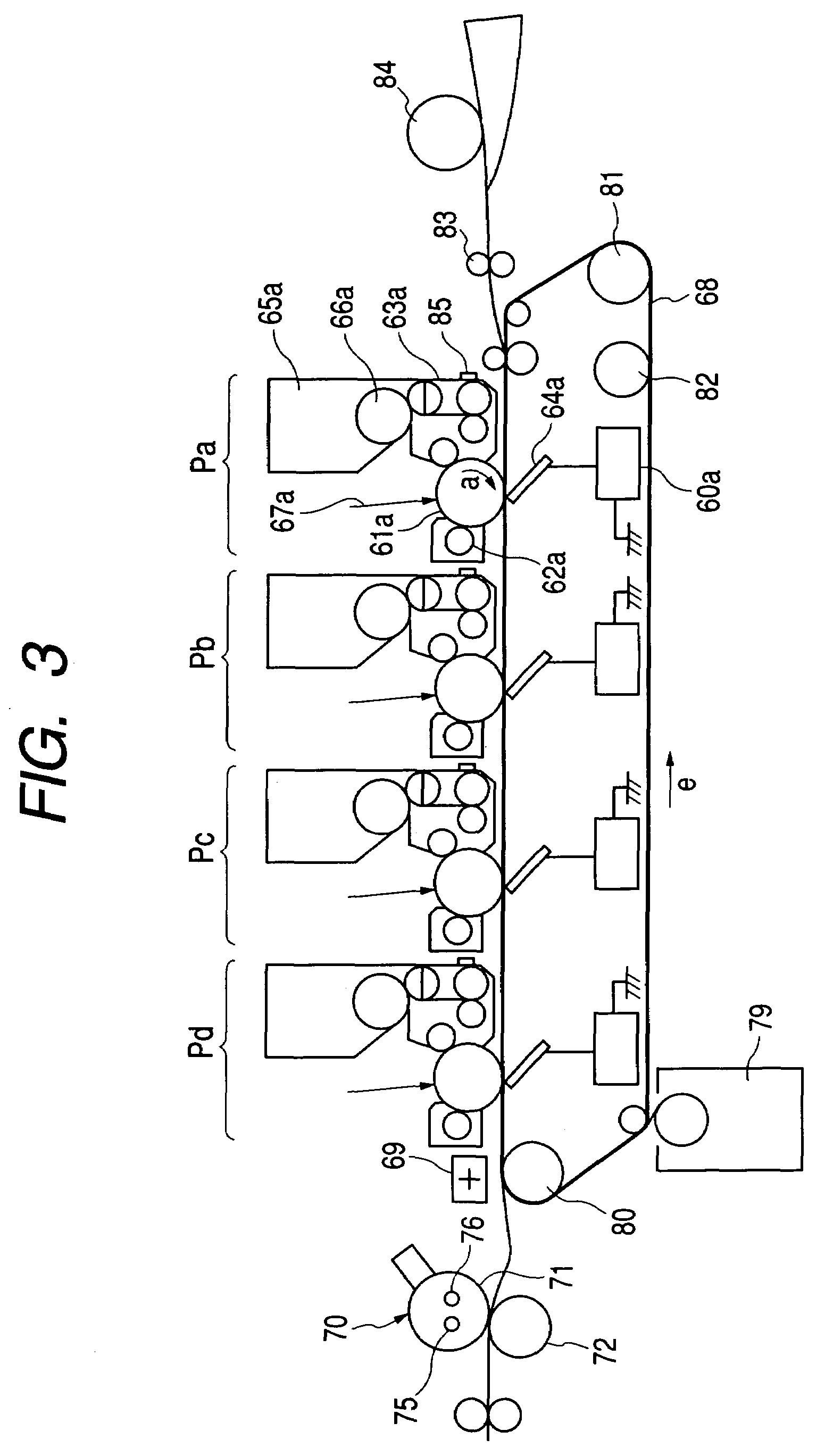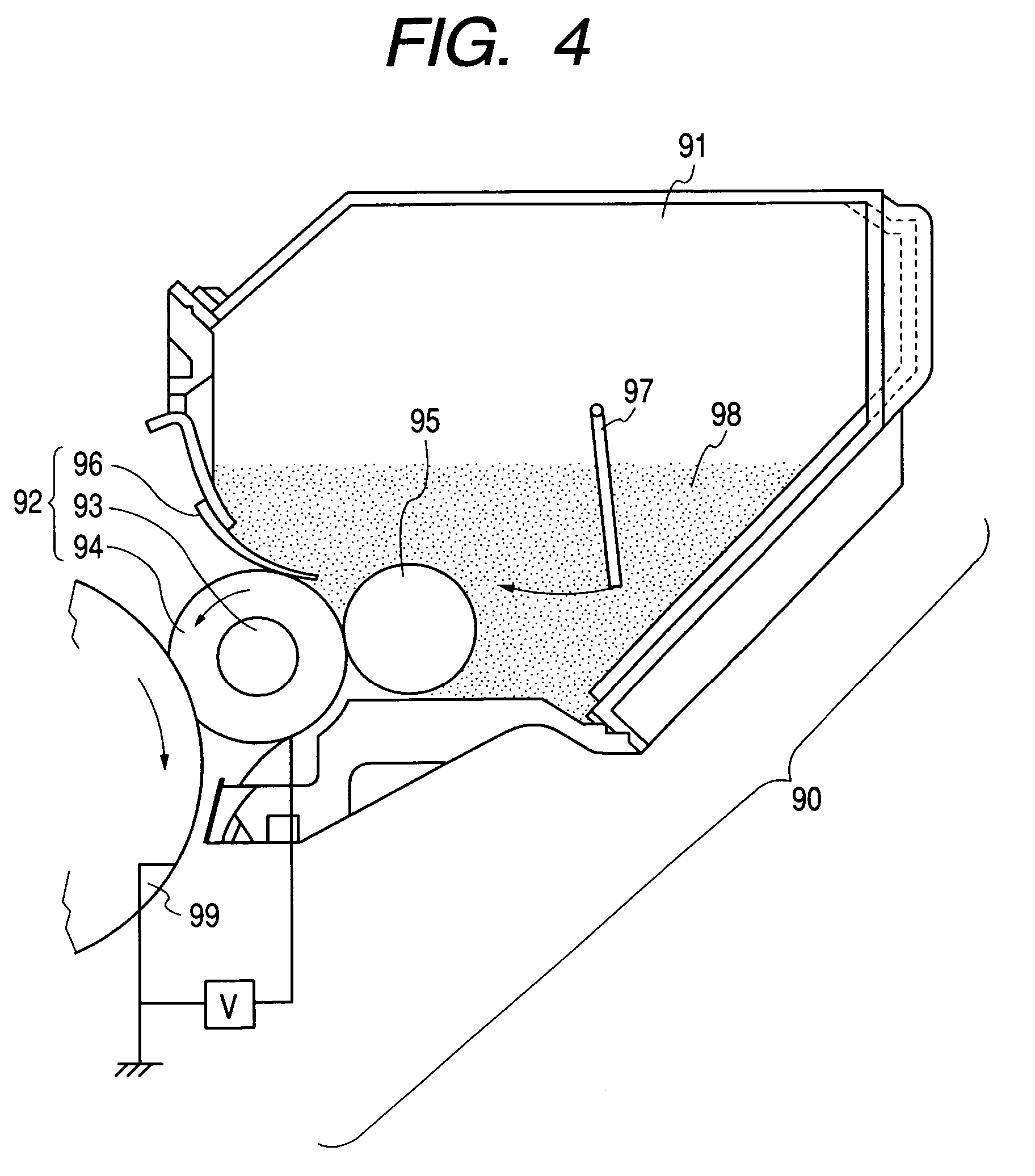Toner
a technology of toner and sleeve, applied in the field of toner, can solve the problems of deterioration of external additives, toner, toner layer thickness control members, toner to be fixed, etc., and achieve the effect of high-temperature anti-offset and superior low-temperature fixing performan
- Summary
- Abstract
- Description
- Claims
- Application Information
AI Technical Summary
Benefits of technology
Problems solved by technology
Method used
Image
Examples
production example 1
Magnetic-Carrier Production Example 1
[0414]
Phenol (hydroxybenzene) 50 partsAqueous 37% by weight formaldehyde solution (formalin) 80 partsWater 50 partsAlumina-containing fine magnetite particles280 partssurface-treated with a silane coupling agent having anepoxy group, KBM403 (available from Shin-Etsu ChemicalCo., Ltd.) (number-average particle diameter: 0.22 μm;resistivity: 4 × 105 Ω· cm)Fine α-Fe2O3 particles surface-treated with KBM403120 parts(number-average particle diameter: 0.40 μm;resistivity: 8 × 109 Ω· cm)25% by weight ammonia water 15 parts
[0415]The above materials were put into a four-necked flask, and were stirred and mixed, during which the mixture was heated to 85° C. over a period of 60 minutes and was held at that temperature, where the reaction was carried out for 120 minutes, followed by curing. Thereafter, the reaction product was cooled to 30° C., and 500 parts of water was added thereto. Then, the supernatant formed was removed, and the precipitate formed was ...
production example 2
Magnetic-Carrier Production Example 2
[0421]14.0 mol % of Li2CO3, 77.0 mol % of Fe2O3, 6.8 mol % of Mg(OH)2 and 2.2 mol % of CaCO3 were pulverized and mixed by means of a wet-process ball mill, followed by drying. This was held at 900° C. for 1 hour to effect calcination. The resultant calcined product was pulverized for 7 hours into particles of 3 μm or less in diameter by means of the wet-process ball mill. To the resultant slurry, a dispersant and a binder were added in appropriate quantities, followed by granulation and drying by means of a spray dryer. The granulated product obtained was held at 1,240° C. for 4 hours in an electric furnace to carry out firing. Thereafter, the fired product was broken up, and was further classified to produce Magnetic Carrier 2 formed of ferrite particles of 40 μm in average particle diameter.
example 1
[0422]As an image-forming apparatus, a commercially available color laser printer CP2810 (manufactured by CANON INC.) was remodeled to a printer having a fixing speed of 150 mm / s and being able to reproduce images on 20 sheets / minute.
[0423]Using Developer No. 1 composed of Toner No. 1, an image pattern with a print percentage (image area percentage) of 10% in which circles of 20 mm in diameter, having an image density of 1.5 as measured with a Model 504reflection densitometer manufactured by X-Rite K.K. are provided at five spots, was printed to conduct a 10,000-sheet running (extensive operation) test in each of environments of 23° C. / 5%RH (N / L) and 32.5° C. / 92% RH (H / H). Evaluation was made according to such evaluation methods as shown below. The evaluation results are shown in Table 2. As can be seen from Table 2, substantially good results were obtained in all evaluation items.
[0424](1) Low-Temperature Fixing Performance:
[0425]Evaluation was made using Xx 64 g paper in an enviro...
PUM
| Property | Measurement | Unit |
|---|---|---|
| weight average particle diameter | aaaaa | aaaaa |
| transmittance | aaaaa | aaaaa |
| temperature | aaaaa | aaaaa |
Abstract
Description
Claims
Application Information
 Login to View More
Login to View More - R&D
- Intellectual Property
- Life Sciences
- Materials
- Tech Scout
- Unparalleled Data Quality
- Higher Quality Content
- 60% Fewer Hallucinations
Browse by: Latest US Patents, China's latest patents, Technical Efficacy Thesaurus, Application Domain, Technology Topic, Popular Technical Reports.
© 2025 PatSnap. All rights reserved.Legal|Privacy policy|Modern Slavery Act Transparency Statement|Sitemap|About US| Contact US: help@patsnap.com



